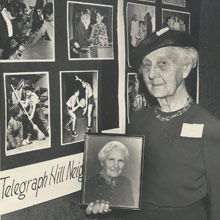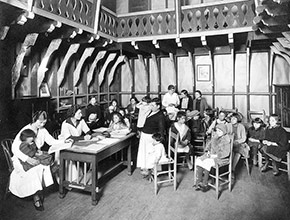Before electricity was widely available, before automobiles were popular, before airplanes even existed, TEL HI was helping people. Many things have changed in the last 134 years or so: our location, our services, the makeup of the neighborhood itself. But throughout our history, the spirit and mission of TEL HI has remained the same.
The Early Years Community Advocates Meeting the Needs of a Changing Neighborhood(This page is a little long, but we’ve been here for 134 years, so there’s a lot of history.)
The Early Years

Alice Griffith with photo of Elizabeth Ashe
TEL HI’s founders, Elizabeth Ashe, 21, and Alice Griffith, 25, began their service to this neighborhood in 1890, when they were teaching Sunday school at Grace Cathedral and got to know some of the local children. Back then the neighborhood was known for its panoramic views from Telegraph Hill and also as a place where Irish, Italian, German, and Latin American immigrants lived in close quarters.
What Ashe and Griffith saw was a community with numerous health and educational needs. Ashe, who later trained as a nurse, and Griffith, a pioneer in the emerging field of social work, were concerned about young children who played unsupervised in the street or were pulled out of school to help support their families by selling flowers or gathering coal.
Immigrants living in huts on the eastern cliffs were helpless to prevent their homes from collapsing as developers chipped away at the hills below to build the Embarcadero. On the western slope of Telegraph Hill, tiny flats without plumbing or heat housed large, extended families. Epidemics of whooping cough, typhoid fever, tuberculosis, and diphtheria took a greater toll here than almost anywhere else in the city.
To tackle these problems, Ashe and Griffith formed what was to become the Telegraph Hill Neighborhood Center, San Francisco’s first settlement house, in 1890. Like Jane Addams, who had just opened Hull House in Chicago, these two well-off and independent young women wanted to work directly with the poor.
 At first, they offered a club for boys and classes in sewing and “domestic science” for girls. Their facility soon expanded to include a kitchen, garden, gymnasium and library. Resident social workers staffed a day care for children of cannery workers, ran a health clinic with an operating room, and taught classes in dancing, singing and dramatics. Nurses were sent out across the neighborhood to teach immigrant mothers new information about health and hygiene, and the center helped launch the first school nurse program on the West Coast.
At first, they offered a club for boys and classes in sewing and “domestic science” for girls. Their facility soon expanded to include a kitchen, garden, gymnasium and library. Resident social workers staffed a day care for children of cannery workers, ran a health clinic with an operating room, and taught classes in dancing, singing and dramatics. Nurses were sent out across the neighborhood to teach immigrant mothers new information about health and hygiene, and the center helped launch the first school nurse program on the West Coast.
In 1905, with the support of Henry E. Bothin, Ashe and Griffith opened Hill Farm Convalescent Home for women and children recovering from tuberculosis. To provide children of the “menacingly ugly, dark tenements” of North Beach with air and light, they were transported to a country cottage in Ross and a summer camp in Fairfax. During the Great Depression, when unemployment and domestic violence plagued the neighborhood, the center built a bocce ball court to provide relief for their fathers. return to top
Community Advocates
Over the years Ashe and Griffith instituted a growing number of programs to help the needy in the community, and they advocated for marginalized residents to ensure they had a voice in their own futures. Outside the center’s walls, Ashe and Griffith were formidable community organizers who enlisted the support of county supervisors, merchants, health officers and others.
When the 1906 earthquake left the center in ruins, Ashe solicited the services of Bernard Maybeck in designing a new one on Stockton Street near Washington Square. The two women led a successful campaign to stop the dynamiting of the hill, but were less successful at saving it from developers. Griffith’s campaign for more open space in the post-quake reconstruction plan failed and the neighborhood became more crowded than ever. return to top
Meeting the Needs of a Changing Neighborhood
By the 1950’s the center had outgrown its Stockton Street location, so Ashe and Griffith led a successful campaign to build our current site at 660 Lombard Street. The building’s proximity to North Beach’s new public housing project along with changing economic forces shifted the center’s clientele. The Cannery and Ghirardelli Chocolate Factory were being converted to shopping malls and the fishing industry was dwindling. TEL HI began serving more African American families who were moving into the North Beach Housing Project and more immigrant Asian families who were living in crowded residential hotels.
The center’s focus shifted from sewing and cooking courses to youth job development and childcare. Today TEL HI continues to support the integration of our entire community. We do this through on- and off-site programs, as well as our collaboration with North Beach Place, a mixed-use, affordable housing complex that opened in 2004.
TEL HI and its neighborhood have changed extensively in the years since Griffith and Ashe, but the convictions and dedication of its founders remain. For the children, youth, families, and seniors participating in TEL HI programs every day, the center maintains its original mission—to sustain and enrich the lives of those in the community through direct services and advocacy. return to top
(Thanks for reading about our history. You won’t be quizzed.)







